Determination of Cefixime Using Batch, Cloud Point Extraction and Flow Injection as New Spectrophotometric Methods
DOI:
https://doi.org/10.23851/mjs.v30i3.648Keywords:
Cefixime trihydrate, Batch method, Cloud point extraction, Bis phenol A, Flow InjectionAbstract
Three simple, sensitive, selective, accurate and efficient spectrophotometric methodsfor determining cefixime in bulk drug and pharmaceutical formulations have
described. The first method involved conversion of NH 2 in cefixime to diazonium
salt, which has coupled with Bisphenol A in an alkaline medium. The orange colored
product showed λ max at 490 nm and followed Beer's law over a concentration range of
1-50 μg mL -1 , with molar absorptivity of 0.866×10 4 L.mol -1 .cm -1 and the detection
limit was 0.157 μg.mL -1 . The second method involved pre-concentration of a trace
amount of cefixime-azo dyes using cloud point extraction (CPE). The extracted drug-
dye was spectrophotometrically measured at λ max 500. The constructed calibration
curve to determine cefixime followed Beer’s law in a range of 0.25-6 μg.mL -1 , with a
correlation coefficient of 0.9998, molar absorptivity of 0.961×10 5 L.mol -1 .cm -1 and
the detection limit was equal to 0.031 μg.mL -1 . The pre-concentration factor was 25
and distribution coefficient (D) was 314.03.
A diazotization of the studied drug (cefixime) and its coupling with Bisphenol A was
studied using a developed flow injection analysis method, based on the detection of
the absorption of the diazotization product. Chemical and physical properties [of
what??] were studied to develop the suggested method and to determine the stability
of the colored of product. A flow rate of 2.5 mL.min -1 , 50 cm reaction coil and 100
μL sample volume were used to operate the system and the orange colored product
was detected at 490 nm. The proposed three methods were successfully applied to
determine cefixime in pharmaceutical formulation, where results were satisfactory
Downloads
Download data is not yet available.
Downloads
Key Dates
Published
14-10-2019
Issue
Section
Original Article
License
(Starting May 5, 2024) Authors retain copyright and grant the journal right of first publication with the work simultaneously licensed under a Creative Commons Attribution (CC-BY) 4.0 License that allows others to share the work with an acknowledgement of the work’s authorship and initial publication in this journal.
How to Cite
[1]
N. kais Abood, M. J. M. Hassan, and M. A. AL-Da’amy, “Determination of Cefixime Using Batch, Cloud Point Extraction and Flow Injection as New Spectrophotometric Methods”, Al-Mustansiriyah J. Sci., vol. 30, no. 3, pp. 28–37, Oct. 2019, doi: 10.23851/mjs.v30i3.648.






















